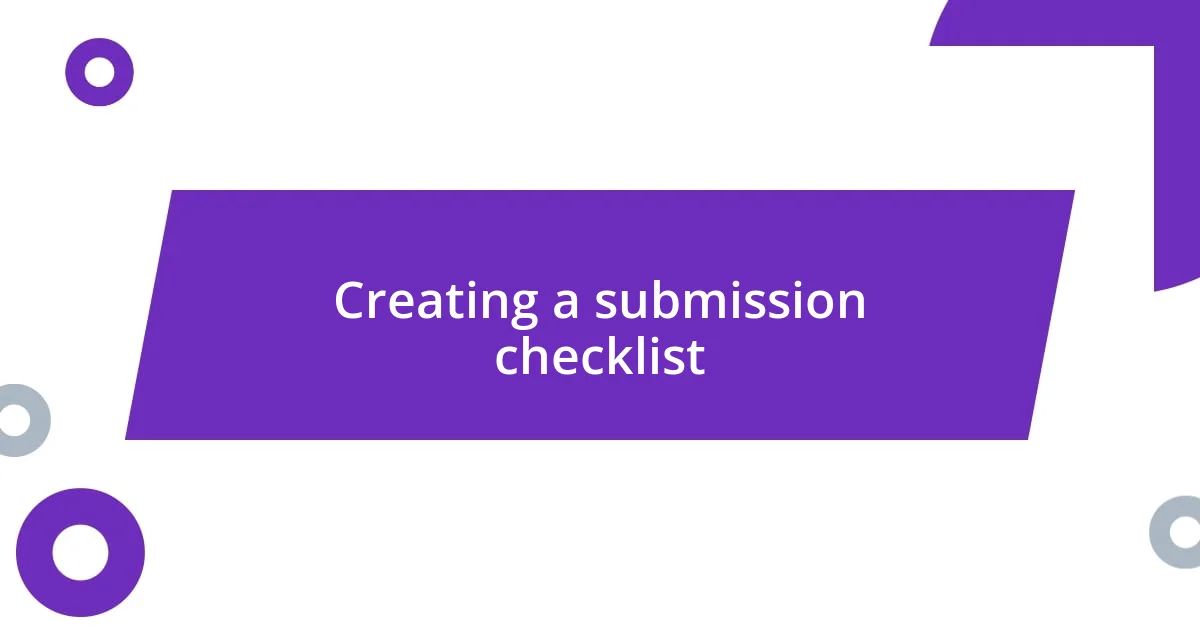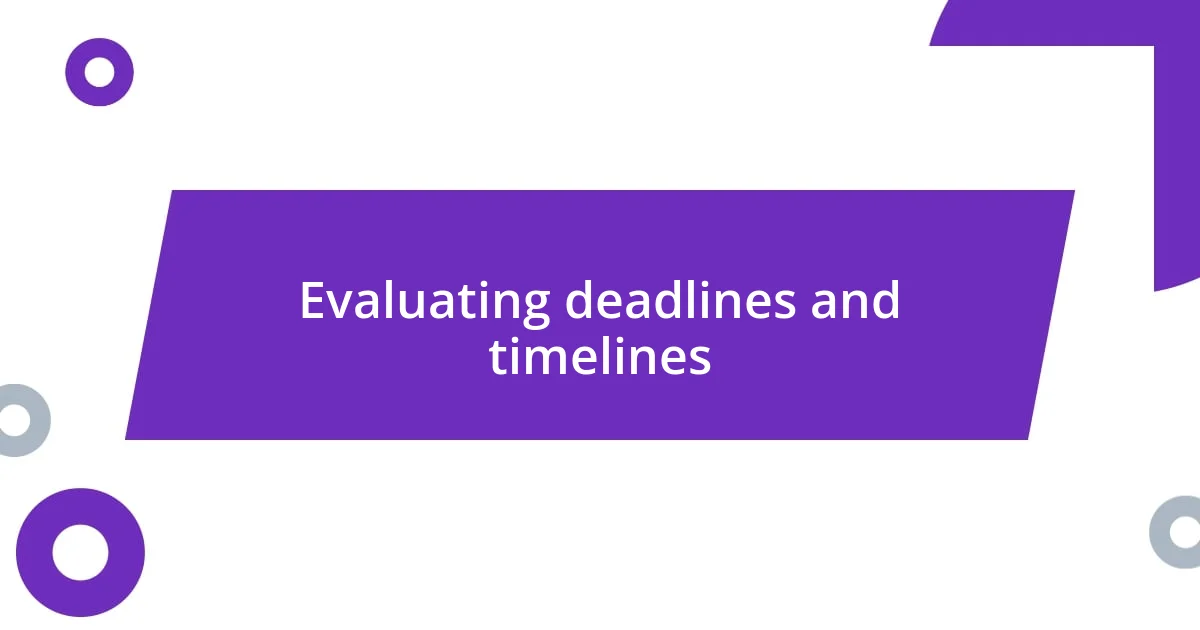Key takeaways:
- Breaking down submission requirements into manageable parts and creating a checklist enhances clarity and effectiveness in the submission process.
- Prioritizing requirements based on relevance, impact, feasibility, and deadlines helps streamline efforts and improve chances of success.
- Utilizing project management tools for organization and time management aids in keeping track of tasks, ensuring quality submissions, and facilitating collaboration.

Understanding submission requirements
Understanding submission requirements can often feel like deciphering a complex puzzle. I vividly remember staring at a guideline document, overwhelmed by the details and formats I needed to follow. It left me wondering, “What does it even mean to have a successful submission?” The key lies in breaking down these requirements into manageable parts.
When I first started submitting projects, I realized the importance of carefully reading each requirement. Missing a small detail can lead to rejection, which I experienced firsthand — it’s a gut-wrenching feeling. So, I learned to highlight the essential points and checklist items before embarking on the submission process. Have you ever overlooked something seemingly minor? I can assure you, the lessons learned can be invaluable.
In my experience, engaging directly with the submission guidelines has helped create a smoother process. I often ask myself, “How can I best present my work within these parameters?” Focusing on clarity and ensuring I meet each requirement has made my submissions more effective. Trust me, investing that extra time in understanding what’s needed pays off down the line.

Identifying key priorities
Identifying key priorities can often be a nuanced process. I remember a particularly challenging project when I spent hours sifting through requirements, trying to decipher which ones truly mattered. By focusing on the impact of each requirement on my submission’s success, I learned that not all priorities hold equal weight. Instead of feeling overwhelmed, I now embrace a structured approach.
Here are some elements I consider when prioritizing requirements:
- Relevance: Is the requirement directly related to the project’s core objectives?
- Impact: Will meeting this requirement significantly enhance my chances of success?
- Feasibility: Can I realistically fulfill this requirement within the given timeline and resources?
- Deadline Alignment: Does this requirement have a specific deadline that affects the overall submission timeline?
- Feedback Source: Have I consulted past submissions or experienced peers regarding this particular requirement?
Each of these factors guides me in distinguishing what truly deserves my attention, ensuring I target my efforts in the right areas.

Creating a submission checklist
Creating a submission checklist is one of the most effective strategies I’ve found for tackling submission requirements. Personally, I like to start with a blank sheet of paper or a digital document where I list every requirement in bullet points. This clear, visual representation gives me a sense of control and makes me feel less overwhelmed. For example, when preparing a recent submission, I noted each requirement and checked them off as I fulfilled them, which kept me motivated throughout the process.
As I compile my checklist, I prioritize requirements based on their significance and clarity. I always ask, “What’s my top priority?” This perspective helps me identify what absolutely needs to be included versus what might simply be optional. During my last submission, I discovered that focusing on key components not only streamlined my efforts but also made my submission stronger. I felt a surge of confidence as I moved systematically through my checklist, knowing I was covering all the bases effectively.
Lastly, including a review step in my checklist is crucial. I often set aside time after completing my initial submission to double-check each item against the guidelines. There have been times when I’ve felt a flutter of anxiety before submitting, thinking, “Did I miss anything?” But taking that moment to review alleviates my fears and leaves me with a sense of satisfaction knowing I’ve done my due diligence.
| Checklist Element | Description |
|---|---|
| Required Documents | List all essential forms needed for submission. |
| Formatting Guidelines | Specify any necessary formatting styles (fonts, sizes, margins). |
| Submission Deadlines | Note key dates to ensure timely submission. |
| Review Steps | Plan for a review to ensure all requirements are met. |

Evaluating deadlines and timelines
As I dive into evaluating deadlines and timelines, I often find myself reflecting on how crucial effective time management can be in my submissions. One memorable instance was when I miscalculated a deadline for a grant application and frantically rushed to meet it, leading to a submission that was far from my best work. I learned the hard way that understanding each requirement’s timeline allows me to allocate my efforts wisely, giving ample time for quality over speed.
When assessing deadlines, I always consider the dependencies among requirements. For example, some tasks can’t be completed until I gather specific information from other sources. I recall a project where I underestimated how long it would take to get feedback from a peer. I felt a wave of panic wash over me, thinking I might miss the submission date. I remind myself now to build in buffer time for these uncertainties whenever I map out my timeline.
Ultimately, I ask myself, “What are the consequences if I miss this deadline?” This question keeps me grounded. Recently, I faced a tight deadline for a submission that had the potential to open doors for my career. The pressure was immense, but focusing on the stakes helped me prioritize effectively. I realized then that deadlines aren’t just dates on a calendar; they shape the opportunities we seize.

Organizing supporting documents
When it comes to organizing supporting documents, I find that categorizing them into distinct folders is a game changer. I typically create digital folders labeled by category, such as “Grant Proposals” or “Research Documents.” This tactic not only makes it easy to locate what I need quickly but also gives me a sense of systematization. There’s nothing quite like the relief of knowing that all relevant documents are just a couple of clicks away.
I also think about the order in which I present these documents. In my experience, starting with the most important items, like cover letters or executive summaries, followed by supporting evidence, makes for a compelling read. For instance, during one submission, I arranged my materials so that the key evidence was front and center, which I believe left the reviewers impressed and engaged right from the start. Have you ever felt that jolt of confidence when you know your documents are in the right order? It’s empowering.
I can’t stress enough the importance of backup copies. There have been moments when my heart sank as I realized a file was missing just before a submission deadline. Now, I ensure that every document is backed up on the cloud, and I have physical copies ready if needed. I always ask myself, “What if something goes wrong?” This simple precaution saves me from a mountain of stress and allows me to focus on what truly matters: presenting my work effectively.

Utilizing project management tools
Utilizing project management tools has transformed how I handle submission requirements. For instance, I started using Trello to visually map out my projects. Each task translates into a card that I can move along different stages of completion. There’s something satisfying about dragging those cards to “Completed” that fuels my motivation. Have you ever experienced that small thrill of checking off a task? It keeps me on track and reminds me of what still lies ahead.
When I initially began using Asana, I was struck by its potential for collaboration. I remember working on a team grant proposal, and with all of us in different locations, clear communication was essential. Asana allowed us to assign tasks, set deadlines, and comment on each item, creating a shared space for our ideas and progress. The real-time updates alleviated my anxiety about whether everyone was on the same page. It’s like having a virtual meeting room without the awkwardness of scheduling!
Moreover, I utilize Gantt charts within these management tools, helping me visualize the entire scope of a project at a glance. The first time I created one for a comprehensive research submission, I distinctly remember feeling overwhelmed by the sheer volume of tasks. But once mapped out, the chart revealed not just the work ahead but also the interdependencies. I realized I could start overlapping tasks that didn’t rely on one another, effectively managing my time. Have you ever wondered how a simple visual could shift your perspective? That’s the power of these tools – they simplify complexity and guide my focus where it’s needed most.

Reviewing and finalizing submissions
When it comes to reviewing and finalizing submissions, I always begin with a fresh set of eyes. I take a break after completing my documents to return with a clear mind. This simple trick has saved me from overlooking pesky typos or formatting inconsistencies. Have you ever submitted something only to find mistakes afterward? It’s a feeling I strive to avoid, and stepping away helps me catch those little errors that could otherwise slip through the cracks.
After that initial review, I make it a point to have another pair of eyes look at my work. Sometimes, I’ll share my documents with a trusted colleague. Their perspective can highlight areas that may need clarification or additional detail. I remember one instance where a friend pointed out a section that was too technical for the audience. Their feedback allowed me to simplify my language while retaining the necessary depth. Isn’t it incredible how collaborative efforts can enhance the overall quality of our submissions?
Finally, I always ensure that my submission aligns with the requirements outlined by the recipient. This has been a lesson learned the hard way. During a crucial grant application, I overlooked a specific word count limit that led to an automatic rejection. Now, I triple-check everything—requirements, deadlines, and submission formats. I often ask myself, “Would I want to review this?” It’s a guiding question that keeps me focused on delivering my best work.














